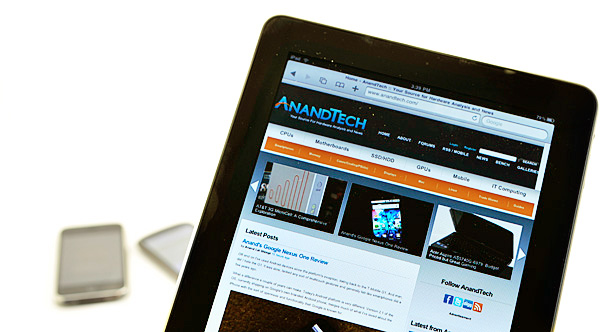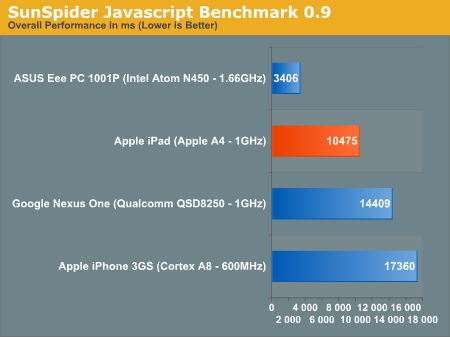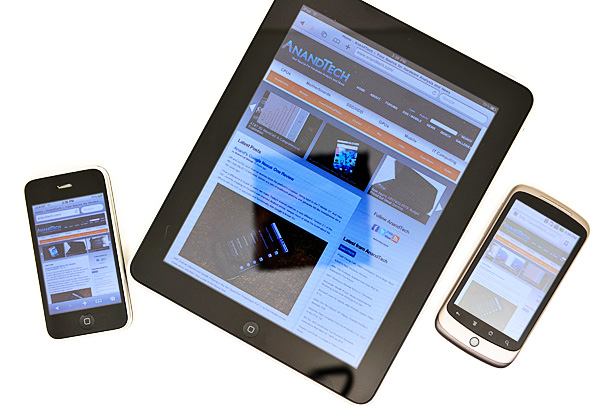Apple's iPad A4 SoC: Faster than the Nexus One's Snapdragon?
by Anand Lal Shimpi on April 3, 2010 3:52 PM EST- Posted in
- Smartphones
- Mobile
Fresh out the frying pan and into the fire, I just finished my Nexus One review late last night only to have my iPad preorder show up early this afternoon. I had been preparing for it's arrival not by downloading apps but by figuring out what comparative benchmarks I wanted to run on the iPhone 3GS and Nexus One.

As the first device to use Apple's A4 SoC I wanted to see how it stacked up against the Cortex A8 and Qualcomm's QSD8250. All three chips appear to be dual issue in order architectures with varying pipeline depths, clock speeds and cache sizes.
At 600MHz the Cortex A8 in the iPhone 3GS is the slowest out of the bunch. The Snapdragon is much faster as we just established thanks in part to it's 1GHz clock speed. But what about Apple's 1GHz A4?

There's very little we know about the A4 other than it's operating frequency. It is manufactured by Samsung but on an unknown process node. Jon Stokes recently stated that Apple's secrecy surrounding the chip is because it isn't anything special, just a Cortex A8. If that is true, I suspect that it would have to be manufactured at 45nm in order to reach such a high clock speed.
With a new silicon mask there's also the chance that Apple moved to LPDDR2 to boost memory bandwidth; a change that most SoC makers are planning to make this year.
So how does Apple's A4 stack up against today's favorite smartphone brainchild? Keep in mind that these results are generated by running two different OSes (Android 2.1 and iPhone OS 3.2) and two different browsers. What we're looking at is the performance delivered by the combination of the CPU and the software stack:
| Applications Processor Performance | ||||||
| Apple iPad (Apple A4) | Apple iPhone 3GS (ARM Cortex A8) | Google Nexus One (Qualcomm Snapdragon QSD8250) | % A4 Faster than Snapdragon | |||
| Load www.anandtech.com | 6.2 seconds | 9.3 seconds | 8.8 seconds | 41% | ||
| Load www.digg.com | 10.6 seconds | 18.0 seconds | 11.5 seconds | 8.7% | ||
| Load www.tomshardware.com | 7.9 seconds | 13.9 seconds | 8.6 seconds | 8.7% | ||
| Load www.arstechnica.com | 7.8 seconds | 13.8 seconds | 11.0 seconds | 39.9% | ||
| Load www.legitreviews.com | 6.8 seconds | 12.3 seconds | 8.6 seconds | 26% | ||
| Load www.techreport.com | 3.7 seconds | 7.4 seconds | 4.2 seconds | 11.6% | ||
| Load www.engadget.com | 13.8 seconds | 22.8 seconds | 22.0 seconds | 59.4% | ||
| Load www.gizmodo.com | 14.1 seconds | 21.4 seconds | 16.7 seconds | 18.5% | ||
| Load m.cnn.com | 3.0 seconds | 6.0 seconds | 2.6 seconds | -11.8% | ||
Unless otherwise specified, I loaded the full version of all of the websites above (the exception being CNN, where I used the mobile site). To ensure reliability, I ran all of these tests at least 5 times, threw out any outliers and averaged the rest. The rests were also run at around the same time to ensure that content on the sites was as similar as possible (and thus shouldn't be compared to this morning's Nexus One results). You'll note that the Engadget results are a bit odd. It looks like the iPhone and Nexus One scores are bottlenecked somewhere else (there seemed to be some network issue plaguing the loads, but it wasn't present on the iPad), but if you toss out the very large differences you end up with what I believe to be the real story here. Update: Flash wasn't enabled on any device (not supported on iPad/iPhone, not officially available on Android yet), and all three devices connected to the same WiFi network. The Apple devices used mobile Safari, while the Android device used the Android Browser. Both are WebKit based but there are obvious, unavoidable software differences.
Removing the AnandTech, Ars Technica and Engadget loads (which were repeatable, but unusually long) the iPad loads web pages 10% faster than the Nexus One. If you include those three results the advantage grows to 22.5%. I'd say somewhere in the 10% range is probably realistic for how much faster the A4 is compared to the Snapdragon.
I also ran the official WebKit SunSpider JavaScript Benchmark on all three platforms to give us a network independent look at real world JavaScript performance:

If we take the network out of the equation, the A4 in the iPad has a 37.6% performance advantage over the Qualcomm QSD8250. This actually supports some of the larger performance differences we saw earlier. If Apple can manage to deliver this sort of performance in its smartphone version of the A4, we're in for a treat.
The why is much more difficult to ascertain. It could be as simple as the the iPad OS being better optimized than Android, a definite possibility given how much longer Apple has been working on it compared to Google. The advantage could also be hardware. The A4 may boast higher IPC than Qualcomm's Snapdragon thanks to better core architecture, larger caches or a faster memory bus. The likely case is somewhere in between, where the iPad's advantage comes from a combination of hardware and software.

It could also be a power optimization thing. The A4 in the iPad is paired with a much larger battery than the QSD8250 in the Nexus One, Apple may be able to run the SoC at more aggressive performance settings since it doesn't have to worry about battery life as much. Either way the one thing we can be sure of is Apple's A4 SoC is much more like a 1GHz Cortex A8 rather than anything more exotic. Good work Jon :)
I should note that while the performance improvement is significant, it's not earth shattering. Despite the early reports of the iPad being blazingly fast, I found it just "acceptable" in my limited time with it thus far. I'll go into greater detail in my full review later.
This does bode well for the upcoming 4th generation iPhone, which is widely expected to also use the Apple A4 SoC. That upgrade alone should put the next iPhone ahead of Google's Nexus One in performance, assuming that it offers the same performance as it does in the iPad. Pair it with a modernized and feature heavy iPhone OS 4.0 and we might see an Apple answer to Android in 2010.
The A4 is particularly exciting because it combines Snapdragon-like CPU performance with a PowerVR SGX GPU. A much better option than the aging ATI core used in Qualcomm's QSD8x50 series.
With Apple showing its A4 performance this early, Qualcomm also has a target to aim at. The first single-core 45nm Snapdragon SoC due out in 2010 will run at 1.3GHz. That could be enough to either equal or outperform Apple's A4 based on what we've seen here today.
Expect our full review of Apple's iPad as well as more discussion about the A4 next week. Have a great weekend guys.










159 Comments
View All Comments
bsoft16384 - Sunday, April 4, 2010 - link
The Acer 1410 (1.4GHz Core 2 Solo) took 4.6 seconds to load Engadget (Chrome Stable 4.1.249, Flash disabled). My guess is that an Atom netbook would be around the 6-8 second mark.SunSpider on the Acer 1410 was 729.8ms (Chrome Stable 4.1.249), or about 14 times faster than the iPad (and about half as fast as the ThinkPad).
Looks like ARM Cortex A8 (even in the form of the A4) still can't hold a candle to Core 2 in terms of performance.
Anand Lal Shimpi - Sunday, April 4, 2010 - link
I agree that the software differences do contribute to the performance difference - the question is: how much? Unfortunately we'll probably never get an identical software stack running on A4 vs. Snapdragon, so this may end up being the closest we get.I've updated the title and added some text in the article itself to hopefully make the comparison and its potential influencers more clear.
Take care,
Anand
misaki - Sunday, April 4, 2010 - link
I wouldn't be so sure about #5.While the base rendering engines are all based on webkit, the javascript engine in android/chrome is completely google's own code (V8), and NOT from webkit. Chrome's release of the V8 engine really lit a fire under all the browsers to work on performance tuning and the comparison to even a year ago is astounding.
bsoft16384 - Sunday, April 4, 2010 - link
I'm not so sure V8 is faster. Safari 4.0 on my Acer 1410 did the SunSpider benchmark in 820ms, which isn't far behind the Chrome result.All of this is academic since you can't compare CPU performance by looking at a JS benchmark running on different engines on different CPUs.
Unless Safari on Windows is magic though (or the iPad JS engine is terrible), it does seem that a Core 2 Solo at 1.4GHz basically destroys the A4 in the iPad. Which kind of makes the fact that the OS and browser are decently responsive that much more impressive.
TemplarGR - Sunday, April 4, 2010 - link
1) To clarify, it may be a SoC and all major systems on package, but it may use for example more advanced parts like WiFi controllers etc. As i said i do not claim to know what exactly is in there but it may affect performance.3) The larger battery allows more power for the same autonomy, but i believe most will be used for the bigger screen anyway. My comment was more about thermals, but more power available could have some impact in the form of fewer cuts needed.
My overall point is that we cannot compare CPUs directly in those devices, and iPAD is obviously faster than Nexus. If it was't faster, it would be a disaster considering their difference in size and role.
Anand Lal Shimpi - Sunday, April 4, 2010 - link
1) All devices have WiFi support. The implementation of WiFi may differ across them but the SunSpider test is network independent so that should rule out WiFi as a cause of the gap. All in all it boils down to the SoCs (which are comparable) and the software stack (which aren't).3) The verdict isn't out yet on thermals. Like I said, there's nothing that blatantly screams the A4 is running too hot for a smartphone and other manufacturers will be shipping 1GHz Cortex A8s with PowerVR SGXs into smartphones later this year. Expecting this level of performance out of the next iPhone I don't believe is unreasonable.
I agree that we can't make a perfect CPU comparison between the A4 and Snapdragon, however I don't believe that means we shouldn't try :)
Take care,
Anand
Cali3350 - Sunday, April 4, 2010 - link
1. They are absolutely in the same class. The iPad uses the same hardware as phones. Its larger in terms of screen real-estate and dimension, however NOT in terms of whats actually powering the thing. There are numerous places to see thishttp://www.ifixit.com/Teardown/iPad-Teardown/2183/...
2. Package size is identical when comparing actual dimensions, which makes complete sense given number 1.
To say something along the lines of "I want to believe Anand isnt biased..." when you have so little information with which you base your claims is simply foolish, and thats exactly how your coming off here. The Nexus One, the iPhone 3GS, and any other smartphone, are directly comparable to the iPad from a pure hardware standpoint which is the reason this article exists and why Anand is so excited to test this processor.
Now, your comments about the OS are true, however out of Anand's hands. There is no "Super PI" port that runs identical code via a native app for all systems, so he needs to use javascript and the like as a baseline.
Rob94hawk - Sunday, April 4, 2010 - link
The iphone is one thing but people lining up for this overrated piece of crap is borders on irresponsible spending. But you know the saying, "there's a sucker born every minute."TemplarGR - Sunday, April 4, 2010 - link
From what i can understand, this is Apple's strategy overall. To target suckers. I may be wrong, but apart from design i see nothing special in all Apple's devices and OSes.I haven't done a detailed benchmark on my Acer Aspire One netbook, which runs ArchLinux with KDE, but it certainly loads pages much faster than iPad. To me this means a lot, as my netbook is 8,9", comparable to the iPad. Of course it is not as thin, but it sports a big hard drive, a web cam, two card slots and a true keyboard.
It should not be difficult for netbook makers to clone the iPAD, and they will trash its performance easily, while having much more software AND Flash support... I believe they will also be cheaper. So when this happens, anyone still buying the iPAD could be considered a sucker...
metafor - Sunday, April 4, 2010 - link
I'm curious whether it's hardware or software. From the numbers of the SunSpider numbers, it would appear the A4 is exactly what a Cortex-A8 would be at 1 GHz (60% higher than the 600MHz A8 inside the iPhone).To isolate software vs hardware, just take a Cortex-A8 Android phone using a similar version of Android (1.6 I believe?). The Droid is the closest thing I can think of OTOH. But I'm sure you know more than I do.
I believe the Droid and N1 also use the same browser? If it isn't too much trouble, put up the Droid performance numbers and we can probably extrapolate how much of the difference is software/browser based.